One-pipe heating system of a private house - a general question on the device

All people prefer to live in a comfortable environment with all amenities. Everyone wants a comfortable and warm home. Residents of urban apartments in this regard are easier. But the owners of private housing construction have to take care of themselves. In order for the rooms to have a comfortable temperature and in cold weather, you need to heat the room.
There are several options for this depending on the heat source and installation method. Among the owners of country houses, the one-pipe heating system is most popular, the installation of which is cheaper than the two-pipe. However, in order to get the maximum heat transfer at the minimum energy costs, you need to calculate everything correctly.
Content
Basic structural elements
In a single-pipe heating system there is no distribution between the supply and return pipes. Therefore, the entire trunk is conditionally divided in half and the pipe extending from the boiler is called the feed, and the second half is called the return.
What is a one-pipe heating system or, more simply, “Leningradka”? To answer this question you need to know what it consists of.
The main elements of such a system:
- The boiler in which the coolant is heated. It can work on solid fuel, electricity or gas.
- Heating elements - radiators. The heated coolant, entering them, gives heat to the rooms.
- Expansion tank to compensate for the expansion of the coolant.
- Pipe routing elements: pipes, valves and taps.
The principle of operation of a one-pipe heating system does not depend on the type of heating device and fuel used, including solid fuel, for more details about the types of which can be found in our article:https://aquatech.tomathouse.com/en/otoplenie/alt_otoplenie/brikety-dlya-otopleniya.html.
Advantages and disadvantages of a single pipe system
How does a single pipe work? private house heating system? The coolant (most often water) is heated in the boiler and rises, being replaced by cold water. Then it enters the first heating element, after which it enters the next one and returns to the boiler for subsequent heating. This creates the movement of coolant through the system. At the same time, in each radiator there is a loss of heat and the last in the chain will be the coldest. This feature is perhaps the only drawback of the system.
How do you get out of this situation? The first way is to increase the size of each subsequent radiator or their number in the room.The second is the installation of control valves. The third is the use of a circulation pump. For more efficient operation of the system, pipes are laid so that radiators located in rooms with the greatest heat loss go first. It can be rooms with windows facing the north side or corner.
The circulation pump is connected where the coolant has the lowest temperature. That is, at the end of the return.
But here are the advantages of a one-pipe heating system:
-
- lower material costs compared to a 2-pipe;
- more aesthetic appearance, the pipe passes above or below the floor and is easier to hide;
- selection of the flow direction of the coolant;
- the ability to lay pipes under the doorways;
the laying of the heating main does not depend on the plan of the house and runs from below along the external walls.
It is not advisable to use a vertical layout of single-pipe systems if more than 10 radiators are connected to the riser.
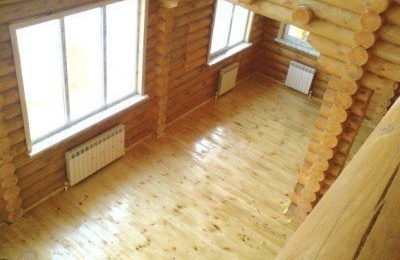
After installing the pipes in the wall, they can be successfully hidden. This will give the room a more aesthetic look.
An overview of a two-pipe heating system with classification, advantages and disadvantages is presented in the following material:https://aquatech.tomathouse.com/en/otoplenie/razvodka-otopitelnoj-sistemy/dvuxtrubnaya-sistema-otopleniya-chastnogo-doma.html.
Why is a heat engineering calculation necessary?
To know the required amount of heat to ensure comfortable conditions in the premises, you need to make a heat engineering calculation. There are special programs for this. Having made the correct calculation of a single-pipe heating system, you will know which radiators to choose and how much, the required power of the heating boiler.
The correct calculation will allow you to choose the amount of equipment you need. And you do not have to overpay, taking the goods in reserve. In addition to the calculation, it is necessary to make a wiring diagram of the heating system. This will be very helpful during installation. It is most correct when a one-pipe heating scheme of a private house is drawn on a building plan made on a convenient scale. So you can calculate the required length of the pipeline.
What are the types of single pipe systems?
According to the installation scheme:
- vertical
- horizontal.
Connection Method:
- associated;
- dead ends.
Circulation method:
- gravity;
- forced.
In buildings with a height of more than 30 meters, it is not cost-effective to install systems with natural circulation.
Vertical heating system
With vertical wiring, the water heats up, rises along the riser, from where it passes through the distribution pipes to the radiators.
The movement of the coolant occurs in a natural way. The efficiency of the system is achieved by using large-diameter pipes and the location of the highway at a slope. Such pipes are harder to hide. However, this drawback is covered by independence from power supply.
Horizontal wiring system
Unlike vertical, a single-tube horizontal heating system does not have a supply riser. The main line can be mounted in the floor structure itself or pass over it. In the first embodiment, to avoid heat loss, it is necessary to conduct pipe insulation. The supply line is also sloped.
How to install radiators?
There are two ways to connect heating elements to the system:
- with flow connection;
- with trailing sections.
With flow connection
Water entering from above in series connected radiators, going all the way, is significantly cooled. At the same time, it is impossible to regulate the temperature of the latter in the instrument circuit with the help of taps.Because of this, a similar method is used in small areas.
With closing sections
In contrast to the system with a flow-through connection, in this between the pipes of the inlet and the outlet of the radiator a closing section of the pipe is mounted. Its diameter should be one size smaller than the main line. This trailing section called bypass. How is this system better? The water from the riser is distributed in two streams. Part goes to the radiator, and part further through the system.
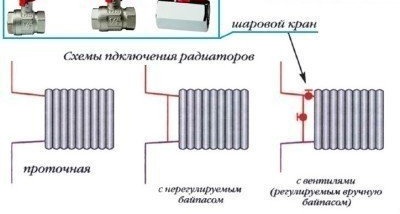
Most often, radiators are connected to the system using bypass - it is much more convenient to maintain the entire system.
It is possible to connect control valves at the inlet to the radiator and this will not affect the main stream.
If necessary, the heating elements can be completely turned off. This allows you to adjust the temperature in all rooms.
You may also find useful material about choosing heating radiators:https://aquatech.tomathouse.com/en/otoplenie/radiatory/kak-vybrat-radiatory-otopleniya.html.
Single pipe installation sequence
In what sequence are the work performed:
- Installation of a heating boiler
- Finishing the walls on which the radiators will be mounted. You will not be able to do this after installation since the distance to the wall will be 3-5 cm.
- The next step is to fix the heating devices.
- Designation of places for fastening pipes, equipment and tie-ins.
- According to the marks, pipes are cut and connected to the bends.
Installation of the pipeline is carried out sequentially. They start from the heating boiler, connect all radiators, along with the installation of all elements of the system.
In conclusion, you need to fill the system with water and check its operation.
When laying the pipeline, make sure that there is no reverse slope. This can lead to airing of the system and its failure.
In private housing construction, you can make heating from 2 independent sources. To do this, put the boiler in the furnace and draw a line from it. In parallel, connect a gas or electric boiler. Get 2 sources of heat to choose from.
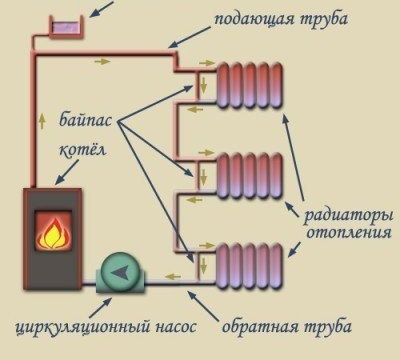
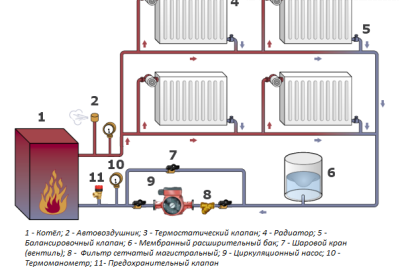
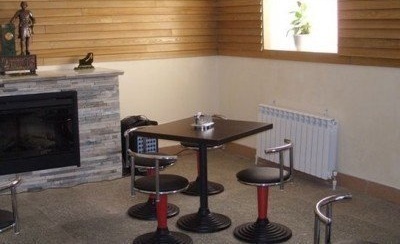
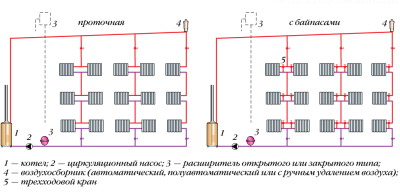


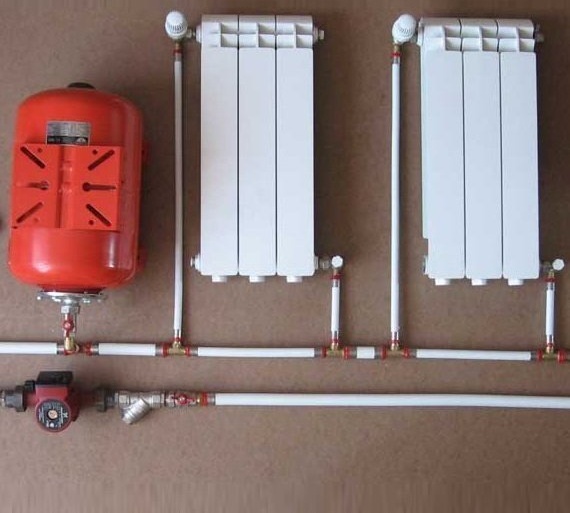

1 comment